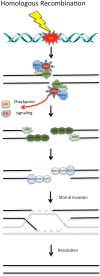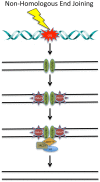Chemotherapeutic compounds targeting the DNA double-strand break repair pathways: the good, the bad, and the promising
- PMID: 24795863
- PMCID: PMC4001069
- DOI: 10.3389/fonc.2014.00086
Chemotherapeutic compounds targeting the DNA double-strand break repair pathways: the good, the bad, and the promising
Abstract
The repair of DNA double-strand breaks (DSBs) is a critical cellular mechanism that exists to ensure genomic stability. DNA DSBs are the most deleterious type of insult to a cell's genetic material and can lead to genomic instability, apoptosis, or senescence. Incorrectly repaired DNA DSBs have the potential to produce chromosomal translocations and genomic instability, potentially leading to cancer. The prevalence of DNA DSBs in cancer due to unregulated growth and errors in repair opens up a potential therapeutic window in the treatment of cancers. The cellular response to DNA DSBs is comprised of two pathways to ensure DNA breaks are repaired: homologous recombination and non-homologous end joining. Identifying chemotherapeutic compounds targeting proteins involved in these DNA repair pathways has shown promise as a cancer therapy for patients, either as a monotherapy or in combination with genotoxic drugs. From the beginning, there have been a number of chemotherapeutic compounds that have yielded successful responses in the clinic, a number that have failed (CGK-733 and iniparib), and a number of promising targets for future studies identified. This review looks in detail at how the cell responds to these DNA DSBs and investigates the chemotherapeutic avenues that have been and are currently being explored to target this repair process.
Keywords: DNA damage repair; DNA damage response; DNA double-strand break; cancer; chemotherapeutic compounds; radioprotective; radiosensitize.
Figures


References
-
- Boder E. Ataxia-telangiectasia: an overview. Kroc Found Ser (1985) 19:1–63 - PubMed
Publication types
LinkOut - more resources
Full Text Sources
Other Literature Sources
Research Materials

